Gender Differences in Visual Perception of Park Landscapes Based on Eye-Tracking Technology: A Case Study of Beihai Park in Beijing
Abstract
1. Introduction
- (1)
- Analyzing the differences in the distribution of visual hotspots for different landscape types between males and females, and exploring the focusing characteristics and preference differences of visual attention between the two genders.
- (2)
- Through eye-tracking experiments, obtaining four eye-tracking indicators for males and females, including average pupil diameter (APD), number of fixations (NF), total fixation duration (TFD), and average fixation duration (AFD), and analyzing the differences in visual landscape perception represented by these indicators.
- (3)
- Through questionnaires, obtaining ratings from males and females on 13 factors, such as landscape spatial sensation, continuity, and spatial coordination, and analyzing the preference degrees of males and females for different landscape types.
- (4)
- Verifying the correlation between the four eye-tracking indicators representing physiological preferences and the landscape perception questionnaire representing psychological preferences, and comprehensively analyzing the gender differences in park landscape perception between males and females.
2. Materials and Methods
2.1. Study Area
2.2. Stimuli
2.3. Selection of Participants
2.4. Experimental Instruments
2.5. Experimental Procedure
- (1)
- The participants were briefed on the experimental objectives, procedures, and safety guidelines. They were directed to sit approximately 1 m away from the display, and they were assisted in securing the eye-tracker’s head-mounted module.
- (2)
- The head-mounted module was properly connected to the recording module. The participant’s name was entered, and the calibration procedure for the Tobii Pro eye-tracker was initiated, ensuring that the participant’s sitting posture and head position were accurately logged. During calibration, the participant was instructed to fix their gaze on the center of the calibration card. The device compensated for individual variations by optimizing the 3D eye model—even if participants differed in sitting height, each calibration session established a new mapping relationship based on their real-time head position [45].
- (3)
- Two warm-up images were presented to mitigate the primacy effect.
- (4)
- The experiment formally began. The first set of landscape photos was displayed, and then participants were instructed to complete the questionnaire. This sequence was repeated until all five sets of images had been presented and all questionnaires had been filled out. Each photo was shown for 8 s, and the entire experiment lasted approximately 10 min (Figure 3).
2.6. Selection of the Eye-Tracking Index
2.7. Subjective Evaluation System
2.8. Data Processing and Analysis
3. Results
3.1. Gender Differences in Visual Hotspots
- (1)
- Overall visual hotspots
- (2)
- Gender differences in visual hotspots
3.2. Differences in Eye-Tracking Indices
3.3. Gender Differences in Questionnaire Scores
3.4. Correlation Analysis Between Eye-Tracking Indices and Questionnaire Scores
4. Discussion
4.1. Visual Landscape Preferences in Traditional Chinese Parks
4.2. Gender Differences in Gaze Distribution Patterns
4.3. Gender Differences in the Eye-Tracking Index
4.4. Questionnaire Results and Gender Preferences
4.5. Research Limitations
4.6. Future Research: Interactive Effects of Age, Cultural Background, and Other Variables
5. Conclusions
5.1. Gender Differences in Spatial Distribution Patterns of Visual Hotspots
5.2. Gender Differences in Physiological Indices of Eye-Tracking Experiments
5.3. Gender Differences in Visual Evaluation Scores
5.4. Correlations Between Physiological Indices and Psychological Evaluations
Author Contributions
Funding
Institutional Review Board Statement
Informed Consent Statement
Data Availability Statement
Acknowledgments
Conflicts of Interest
References
- Graça, M.; Cruz, S.; Monteiro, A.; Neset, T.-S. Designing Urban Green Spaces for Climate Adaptation: A Critical Review of Research Outputs. Urban Clim. 2022, 42, 101126. [Google Scholar] [CrossRef]
- Lo, A.Y.; Jim, C.Y.; Cheung, P.K.; Wong, G.K.L.; Cheung, L.T.O. Space Poverty Driving Heat Stress Vulnerability and the Adaptive Strategy of Visiting Urban Parks. Cities 2022, 127, 103740. [Google Scholar] [CrossRef]
- Park, H.-M.; Jo, H.-K. Ecological Design and Construction Strategies through Life Cycle Assessment of Carbon Budget for Urban Parks in Korea. Forests 2021, 12, 1399. [Google Scholar] [CrossRef]
- Lee, M.-J. Ecological Design Strategies and Theory for Urban Parks in Seoul, 1990s–Present. Land 2021, 10, 1163. [Google Scholar] [CrossRef]
- García, M.G. Paisajes generativos. Del control a lo salvaje mediante el diseño resiliente. Dearq 2019, 25, 200–207. [Google Scholar] [CrossRef]
- González, T.; Berger, P.; Sánchez, C.N.; Mahichi, F. Sustainability of Urban Parks: Applicable Methodological Framework for a Simple Assessment. Sustainability 2023, 15, 15262. [Google Scholar] [CrossRef]
- Constantinescu, M.; Orîndaru, A.; Căescu, Ș.-C.; Pachițanu, A. Sustainable Development of Urban Green Areas for Quality of Life Improvement—Argument for Increased Citizen Participation. Sustainability 2019, 11, 4868. [Google Scholar] [CrossRef]
- Swierad, E.M.; Huang, T.T.K. An Exploration of Psychosocial Pathways of Parks’ Effects on Health: A Qualitative Study. Int. J. Environ. Res. Public Health 2018, 15, 1693. [Google Scholar] [CrossRef] [PubMed]
- Rosso, F.; Pioppi, B.; Pisello, A.L. Pocket Parks for Human-Centered Urban Climate Change Resilience: Microclimate Field Tests and Multi-Domain Comfort Analysis through Portable Sensing Techniques and Citizens’ Science. Energy Build. 2022, 260, 111918. [Google Scholar] [CrossRef]
- Boros, J.; Mahmoud, I. Urban Design and the Role of Placemaking in Mainstreaming Nature-Based Solutions. Learning From the Biblioteca Degli Alberi Case Study in Milan. Front. Sustain. Cities 2021, 3, 635610. [Google Scholar] [CrossRef]
- Rishbeth, C.; Ganji, F.; Vodicka, G. Ethnographic Understandings of Ethnically Diverse Neighbourhoods to Inform Urban Design Practice. Local Environ. 2018, 23, 36–53. [Google Scholar] [CrossRef]
- Loughran, K. Urban Parks and Urban Problems: An Historical Perspective on Green Space Development as a Cultural Fix. Urban Stud. 2020, 57, 2321–2338. [Google Scholar] [CrossRef]
- Wang, Y.; Shi, X.; Hong, H.; Chang, Q. How Does Multiscale Greenspace Exposure Affect Human Health? Evidence from Urban Parks in the Central City of Beijing. J. Environ. Manag. 2024, 353, 120253. [Google Scholar] [CrossRef]
- Zhang, C.; Su, Q.; Zhu, Y. Urban Park System on Public Health: Underlying Driving Mechanism and Planning Thinking. Front. Public Health 2023, 11, 1193604. [Google Scholar] [CrossRef] [PubMed]
- Guo, H.; Luo, Z.; Li, M.; Kong, S.; Jiang, H. A Literature Review of Big Data-Based Urban Park Research in Visitor Dimension. Land 2022, 11, 864. [Google Scholar] [CrossRef]
- Li, K.; Zhai, Y.; Dou, L.; Liu, J. A Preliminary Exploration of Landscape Preferences Based on Naturalness and Visual Openness for College Students with Different Moods. Front. Psychol. 2021, 12, 629650. [Google Scholar] [CrossRef]
- Zigmunde, D.; Ņitavska, N.; Vugule, K.; Storie, J.; Katlapa, A.; Kalniņa, A.; Mengots, A. Landscape Cognition. In Latvia University of Agriculture: Landscape Architecture & Art; Latvia University of Life Sciences and Technologies: Jelgava, Latvia, 2016; Volume 8. [Google Scholar]
- Ma, R.; Luo, Y.; Furuya, K. Gender Differences and Optimizing Women’s Experiences: An Exploratory Study of Visual Behavior While Viewing Urban Park Landscapes in Tokyo, Japan. Sustainability 2023, 15, 3957. [Google Scholar] [CrossRef]
- Day, K. The ethic of care and women’s experiences of public space. J. Environ. Psychol. 2000, 20, 103–124. [Google Scholar] [CrossRef]
- Baron-Cohen, S.; Knickmeyer, R.C.; Belmonte, M.K. Sex Differences in the Brain: Implications for Explaining Autism. Science 2005, 310, 819–823. [Google Scholar] [CrossRef]
- Nasar, J.L.; Julian, D.; Buchman, S.; Humphreys, D.; Mrohaly, M. The Emotional Quality of Scenes and Observation Points: A Look at Prospect and Refuge. Landsc. Plan. 1983, 10, 355–361. [Google Scholar] [CrossRef]
- Braçe, O.; Garrido-Cumbrera, M.; Correa-Fernández, J. Gender Differences in the Perceptions of Green Spaces Characteristics. Soc. Sci. Q. 2021, 102, 2640–2648. [Google Scholar] [CrossRef]
- Jimenez Rosas, E.O. Los Espacios Verdes Públicos de Las Mujeres. La Conectividad Femenina En Los Parques Urbanos. Psicol. Iberoam. 2020, 25, 68–77. [Google Scholar] [CrossRef]
- Tan, N.Y.Q.; Tham, Y.-C.; Koh, V.; Cheung, C.Y.; Aung, T.; Wong, T.Y.; Cheng, C.-Y. The Effect of Gender on Visual Field Sensitivity: The Singapore Chinese Eye Study. Ophthalmic Epidemiol. 2019, 26, 183–188. [Google Scholar] [CrossRef] [PubMed]
- McGuinness, D.; Lewis, I. Sex Differences in Visual Persistence: Experiments on the Ganzfeld and Afterimages. Perception 1976, 5, 295–301. [Google Scholar] [CrossRef] [PubMed]
- Wang, X.; Li, G.; Pan, J.; Shen, J.; Han, C. The Difference in the Elderly’s Visual Impact Assessment of Pocket Park Landscape. Sci. Rep. 2023, 13, 16895. [Google Scholar] [CrossRef]
- Wang, P.; Yang, W.; Wang, D.; He, Y. Insights into Public Visual Behaviors through Eye-Tracking Tests: A Study Based on National Park System Pilot Area Landscapes. Land 2021, 10, 497. [Google Scholar] [CrossRef]
- Shi, Y.; Zhang, J.; Shen, X.; Chen, L.; Xu, Y.; Fu, R.; Su, Y.; Xia, Y. Designing Perennial Landscapes: Plant Form and Species Richness Influence the Gaze Perception Associated with Aesthetic Preference. Land 2022, 11, 1860. [Google Scholar] [CrossRef]
- Polko, P.; Kimic, K. Gender as a Factor Differentiating the Perceptions of Safety in Urban Parks. Ain Shams Eng. J. 2022, 13, 101608. [Google Scholar] [CrossRef]
- Pérez-Tejera, F.; Anguera, M.T.; Guàrdia-Olmos, J.; Dalmau-Bueno, A.; Valera, S. Examining Perceived Safety and Park Use in Public Open Spaces: The Case of Barcelona. J. Environ. Psychol. 2022, 81, 101823. [Google Scholar] [CrossRef]
- Qi, T.; Wang, Y.J.; Wang, W.H. A review on visual landscape study in foreign countries. Prog. Geogr. 2013, 32, 975–983. [Google Scholar]
- Wang, Y.; Chen, X.F. Application of psychophysical method in evaluation of foreign forest landscapes. Sci. Silvae Sin. 1999, 35, 110–117. [Google Scholar]
- Xiao, J.; Zhong, H.J.; Liu, S.Q.; Ma, C.Y.; Cao, K. Tourist Preference for Landscape in Urban Parks Based on the “Bag of Photographic Words” Model. J. Chin. Urban For. 2022, 20, 87–95. [Google Scholar]
- Xiao, J.; Ma, C.Y.; Cao, K. Research on Recreational Psychology Profiling of Tourists in Urban Parks Based on User Generated Content Image Data. Landsc. Archit. 2022, 29, 96–102. [Google Scholar] [CrossRef]
- Steen Jacobsen, J.K. Use of Landscape Perception Methods in Tourism Studies: A Review of Photo-Based Research Approaches. Tour. Geogr. 2007, 9, 234–253. [Google Scholar] [CrossRef]
- Kim, N.H.; Kang, H.H. The Aesthetic Evaluation of Coastal Landscape. KSCE J. Civ. Eng. 2009, 13, 65–74. [Google Scholar] [CrossRef]
- Dong, S.L.; Ma, J.M.; Xin, W.J. Research Progress and Trend of Landscape Visual Evaluation—Knowledge Atlas Analysis Based on CiteSpace. J. Guangxi Norm. Univ. (Nat. Sci. Ed.) 2023, 41, 1–13. [Google Scholar] [CrossRef]
- Zhu, Y.J.; Dong, J.Y.; Weng, Y.X.; Dong, J.W.; Wang, M.H. Audio-visual Interaction Evaluation of Forest Park Environment Based on Eye Movement Tracking Technology. Chin. Landsc. Archit. 2021, 37, 69–74. [Google Scholar] [CrossRef]
- Luo, Y.S.; Shen, S.Y.; Zhan, W. Research on Experience Evaluation of Cultural Landscape of Zhang Guying Village Based on SD and Eye Movement Analysis. Chin. Landsc. Archit. 2022, 38, 98–103. [Google Scholar] [CrossRef]
- Lin, M.L.; Yang, X.T.; Wang, M. Meaning Reconstruction of Downtown Memorials from the Perspective of Non-representational Theories: A Case Study of the Peasant Movement Institute in Guangzhou. Tour. Trib. 2023, 38, 92–105. [Google Scholar] [CrossRef]
- Kalivoda, O.; Vojar, J.; Skřivanová, Z.; Zahradník, D. Consensus in Landscape Preference Judgments: The Effects of Landscape Visual Aesthetic Quality and Respondents’ Characteristics. J. Environ. Manag. 2014, 137, 36–44. [Google Scholar] [CrossRef]
- Beihai Park. Available online: https://www.beihaipark.com.cn/ (accessed on 11 July 2025).
- Perera, D.; Chandrasekara, D.P. Influence of Gender on Perception of Landscape: A Study of Viharamahadevi Park in Colombo. In Proceedings of the International Forestry and Environment Symposium, Waskaduwa, Sri Lanka, 10–11 November 2017; Volume 22. [Google Scholar] [CrossRef][Green Version]
- Dunn, M.J.; Alexander, R.G.; Amiebenomo, O.M.; Arblaster, G.; Atan, D.; Erichsen, J.T.; Ettinger, U.; Giardini, M.E.; Gilchrist, I.D.; Hamilton, R.; et al. Minimal Reporting Guideline for Research Involving Eye Tracking (2023 Edition). Behav. Res. 2024, 56, 4351–4357. [Google Scholar] [CrossRef] [PubMed]
- TOBII PRO GLASSES 3 USER MANUAL Pdf Download. Available online: https://www.manualslib.com/manual/1936893/Tobii-Pro-Glasses-3.html (accessed on 11 July 2025).[Green Version]
- Yan, G.L.; Xiong, J.P.; Zang, C.L.; Yu, L.L.; Cui, L.; Bai, X.J. Review of Eye-movement Measures in Reading Research. Adv. Psychol. Sci. 2013, 21, 589–605. [Google Scholar] [CrossRef]
- Su, K.; Li, D.P.; Wei, G.F. Ceramic Product Modeling Design Evaluation Method Based on Eye Tracking. Packag. Eng. 2021, 42, 51–56. [Google Scholar] [CrossRef]
- Xue, Y.F.; Zhu, F.Q. Construction of Cognitive Style Model Based on Machine Learning and Eye Tracking. Mod. Distance Educ. Res. 2024, 36, 94–103. [Google Scholar]
- Hou, C.X.; Zhang, M.J.; Zhao, X.Y.; Fu, H.L. Influence mechanism of user comments on public′s consumption intention of recycled water from the perspective of consumers: Evidence from eye tracking experiments. Acta Ecol. Sin. 2023, 43, 5753–5763. [Google Scholar]
- Seresinhe, C.I.; Preis, T.; Moat, H.S. Using Deep Learning to Quantify the Beauty of Outdoor Places. R. Soc. Open Sci. 2017, 4, 170170. [Google Scholar] [CrossRef]
- Cheung, K.C.; Wells, N.M. The Natural Environment & Human Well-Being: Insights from Fractal Composition Analysis? Harmon. Fractal Image Anal. 2004, 1, 76–82. [Google Scholar]
- Gatersleben, B. Humans and Nature; Ten Useful Findings from Environmental Psychology Research. Couns. Psychol. Rev. 2008, 23, 24–34. [Google Scholar] [CrossRef]
- Gao, T.; Liang, H.; Chen, Y.; Qiu, L. Comparisons of Landscape Preferences through Three Different Perceptual Approaches. Int. J. Environ. Res. Public Health 2019, 16, 4754. [Google Scholar] [CrossRef]
- Meng, L.; Lin, B.; Zhang, H.; Bu, R. Sustainable Development Evaluation on the Landscape Design of Industrial Heritage Park: A Case Study of Tao Sichuan, China. J. Environ. Public Health 2023, 2023, 1564614. [Google Scholar] [CrossRef]
- Liu, W.; Zhang, R.; Li, H. Measuring Tourists’ Visual Perception of Gardens around Taihu Lake Rim Area Based on Multi-Source Data. J. Environ. Eng. Landsc. Manag. 2024, 32, 152–168. [Google Scholar] [CrossRef]
- Zhao, J.; Li, R.; Wei, X. Assessing the Aesthetic Value of Traditional Gardens and Urban Parks in China. Proc. Inst. Civ. Eng.—Urban Des. Plan. 2017, 170, 83–91. [Google Scholar] [CrossRef]
- De Lucio, J.V.; Mohamadian, M.; Ruiz, J.P.; Banayas, J.; Bernaldez, F.G. Visual Landscape Exploration as Revealed by Eye Movement Tracking. Landsc. Urban Plan. 1996, 34, 135–142. [Google Scholar] [CrossRef]
- Tarashkar, M.; Hami, A.; Namin, F.E. The Effects of Parks’ Landscape Characteristics on Women’s Perceptual Preferences in Semi-Arid Environments. J. Arid. Environ. 2020, 174, 104080. [Google Scholar] [CrossRef]
- Khaleghimoghaddam, N. A Neurological Examination of Gender Differences in Architectural Perception. Archit. Sci. Rev. 2024, 67, 281–290. [Google Scholar] [CrossRef]
- Holmes, T.; Zanker, J.M. Using an Oculomotor Signature as an Indicator of Aesthetic Preference. i-Perception 2012, 3, 426–439. [Google Scholar] [CrossRef]
- Glaholt, M.G.; Reingold, E.M. Predicting Preference from Fixations 2007. PsychNology J. 2009, 7, 141–158. [Google Scholar]
- Wang, W.; Wang, N.; Hu, F. The Application of Eye-Tracking Technology in Experience Design Research. J. Nanjing Univ. Arts (Fine Arts Des.) 2021, 6, 75–81. (In Chinese) [Google Scholar]
- Güngör, S.; Akyüz, C. Peyzaj Mimarlığında Cinsiyete Göre Tercih Edilen Tasarım Algısı. Turk. JAF Sci.Tech. 2020, 8, 1–7. [Google Scholar] [CrossRef]
- Westover, T.N. Park Use and Perception: Gender Differences. J. Park Recreat. Adm. 1986, 4, 2. [Google Scholar]
- Lyons, E. Demographic Correlates of Landscape Preference. Environ. Behav. 1983, 15, 487–511. [Google Scholar] [CrossRef]
- Yuan, G.; Wang, H.; Wang, M.; Lin, M. Visual Attention and Ethnic Landscape Perception: A Case of Three Cities in the Guangdong–Hong Kong–Macao Greater Bay Area. Appl. Geogr. 2022, 147, 102781. [Google Scholar] [CrossRef]
- Yu, K. Cultural Variations in Landscape Preference: Comparisons among Chinese Sub-Groups and Western Design Experts. Landsc. Urban Plan. 1995, 32, 107–126. [Google Scholar] [CrossRef]
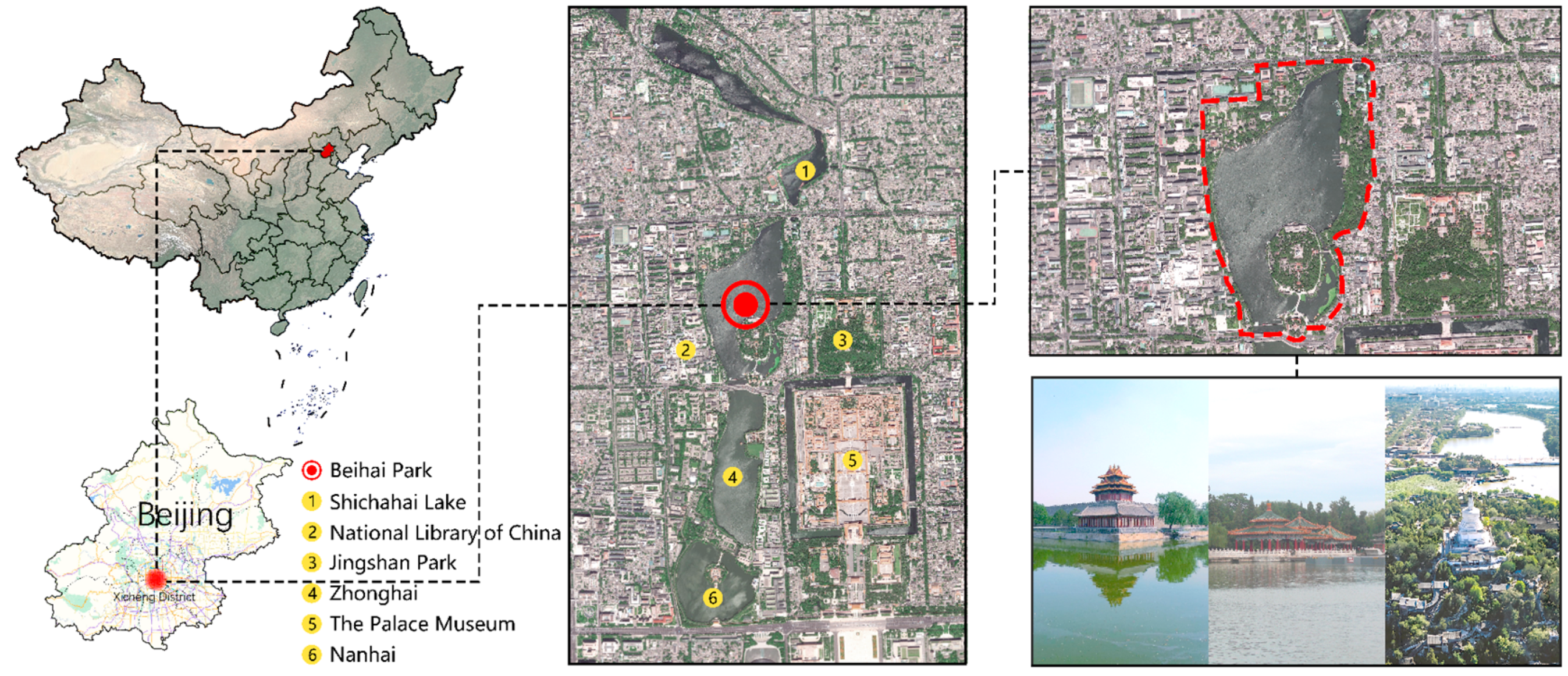
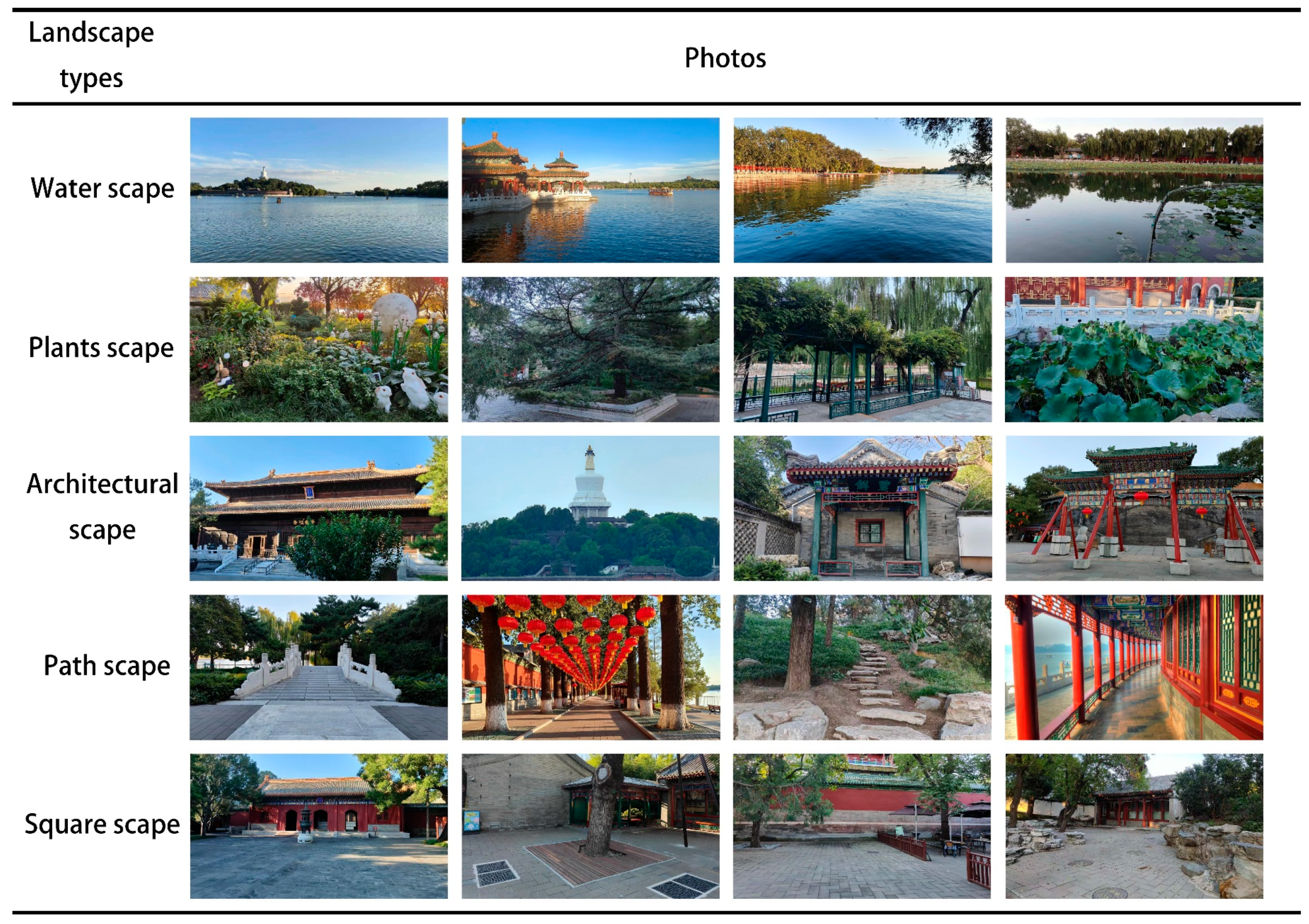

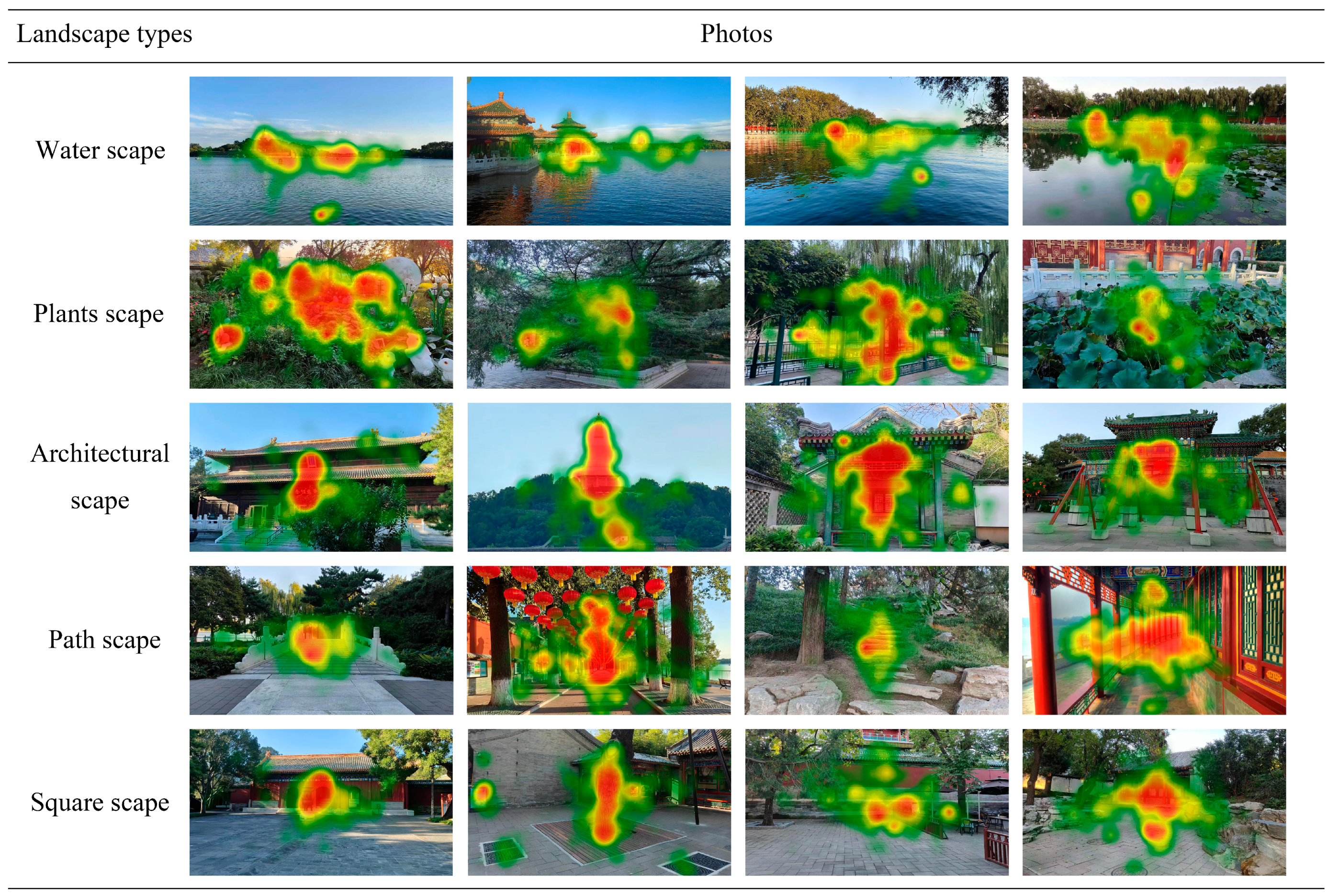
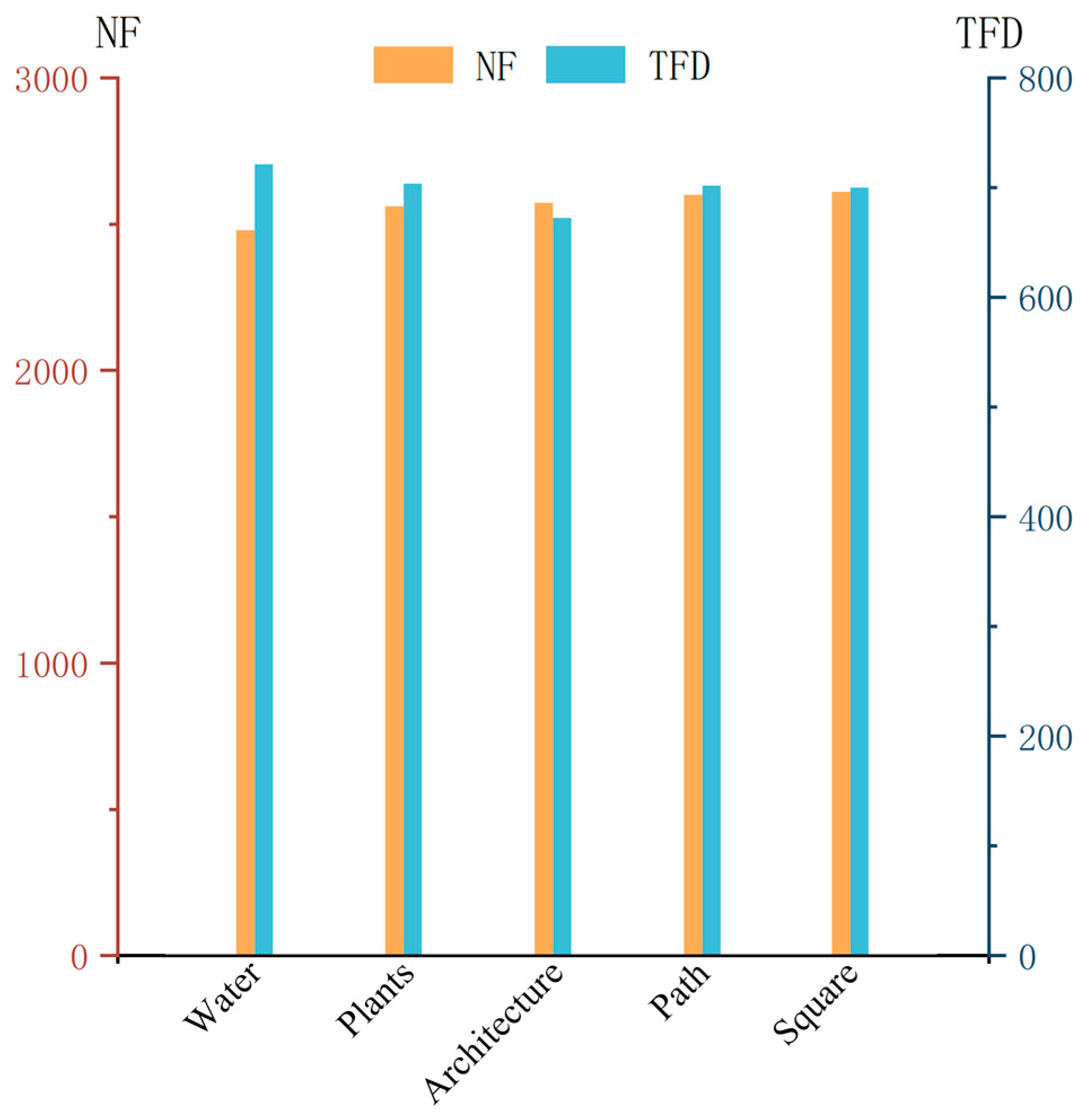

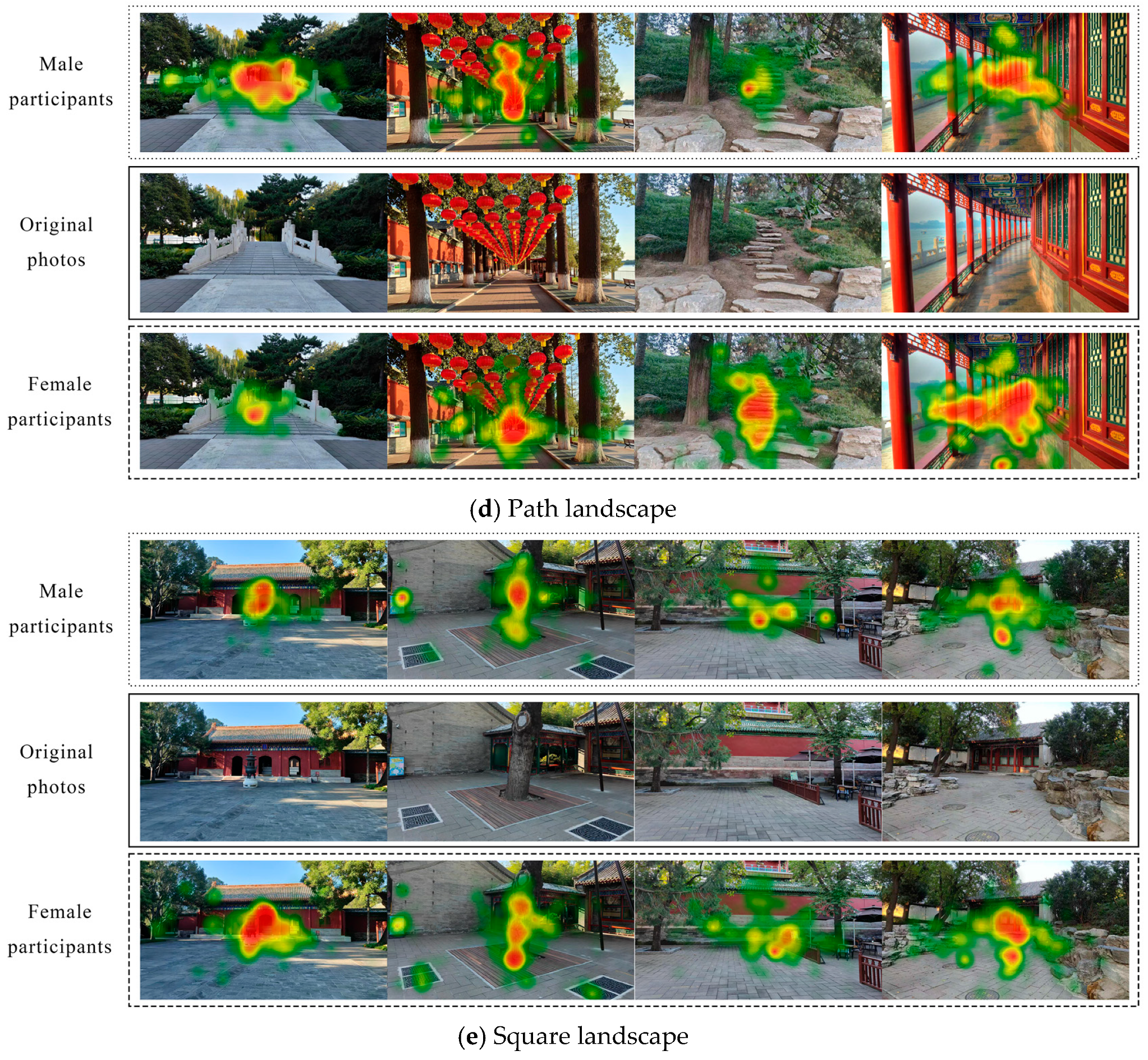
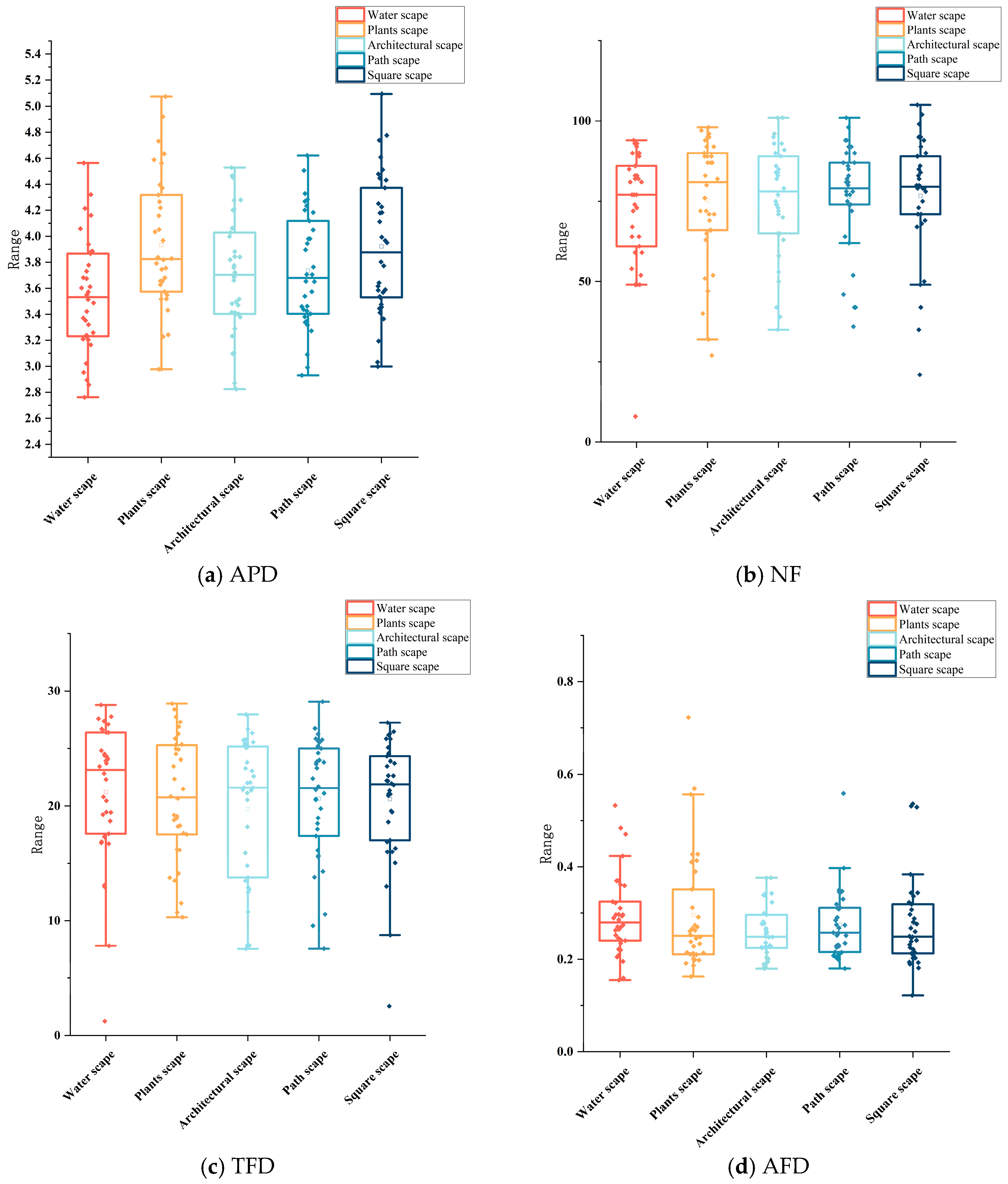



| Metrics | Abbr. | Unit | Definition | Implication |
|---|---|---|---|---|
| Average pupil diameter | APD | mm | Mean dimensions of pupil dilation or constriction during the observation period [46] | Indicating cognitive processing demand and emotional fluctuations. This metric demonstrates high sensitivity, where a 0.1 mm variation in pupil diameter can signify alterations in cognitive states. |
| Number of fixation | NF | Fixation number within a defined area [47] | This index reflects participants’ attentional number towards specific regions or objects. Higher fixation counts indicate greater attentional engagement, which may suggest that the target area/object has higher cognitive relevance or information density during cognitive processing. | |
| Total fixation duration | TFD | s | Fixation duration at specific coordinates [47] | This metric indicates participants’ attentional engagement and temporal allocation toward specific areas. Prolonged fixation durations generally demonstrate enhanced attractiveness or informational salience within the targeted zones. |
| Average fixation duration | AFD | s | Calculated by dividing the total fixation duration within a defined area by the fixation count, which yields the mean dwell time per fixation point [48] | This parameter reflects the attentional allocation and cognitive load of participants under specific task/stimulus conditions [49]. |
| Serial Number | Evaluation Factor | Assign Scores (Likert Five-Point Scale) | ||||
|---|---|---|---|---|---|---|
| −2 | −1 | 0 | 1 | 2 | ||
| 1 | Spatial openness | Extremely Closed | Relatively Closed | Neutral | Relatively Open | Extremely Open |
| 2 | Spatial Continuity | Extremely Discontinuous | Relatively Discontinuous | Neutral | Relatively Continuous | Extremely Continuous |
| 3 | Spatial Coherence | Extremely Incoherent | Relatively Incoherent | Neutral | Relatively Coherent | Extremely Coherent |
| 4 | Aesthetic Feeling | Extremely Unbeautiful | Relatively Unbeautiful | Neutral | Relatively Beautiful | Extremely Beautiful |
| 5 | Spatial distinctiveness | Extremely lacking in distinctiveness | Fairly lacking in distinctiveness | Neutral | Relatively distinctive | Extremely distinctive |
| 6 | Historical and Cultural Heritage | Completely Unperceivable | Difficult to Perceive | Neutral | Obviously Perceivable | Extremely Profound |
| 7 | Color Coherence | Extremely Incoherent | Relatively Incoherent | Neutral | Relatively Coherent | Extremely Coherent |
| 8 | Color Purity | Extremely Cluttered | Relatively Cluttered | Neutral | Relatively Pure | Extremely Pure |
| 9 | Color Richness | Extremely Monotonous | Relatively Monotonous | Neutral | Relatively Rich | Extremely Rich |
| 10 | Curiosity | Extremely Ordinary | Relatively Ordinary | Neutral | Relatively Novel | Extremely Novel |
| 11 | Pleasure | Extremely Unpleasant | Relatively Unpleasant | Neutral | Relatively Pleasant | Extremely Pleasant |
| 12 | Comfort | Extremely Uncomfortable | Relatively Uncomfortable | Neutral | Relatively Comfortable | Extremely Comfortable |
| 13 | Attractiveness | Completely Unattractive | Relatively Unattractive | Neutral | Relatively Attractive | Extremely Attractive |
| Eye-Tracking Indices | Z | Sig. |
|---|---|---|
| APD (mm) | −0.396 | 0.692 |
| NF | −2.015 | 0.044 |
| TFD (s) | −2.807 | 0.005 |
| AFD (s) | −1.464 | 0.143 |
| Landscape Type | Eye-Tracking Indices | Mean (Male) | Mean (Female) | Sig. |
|---|---|---|---|---|
| Water landscape | APD (mm) | 3.526 | 3.553 | 0.718 |
| NF | 66.529 | 79.294 | 0.042 * | |
| TFD (s) | 18.33 | 24.117 | 0.007 ** | |
| AFD (s) | 0.273 | 0.316 | 0.117 | |
| Plant landscape | APD (mm) | 3.925 | 3.94 | 0.931 |
| NF | 71.118 | 79.588 | 0.221 | |
| TFD (s) | 18.361 | 23.008 | 0.017 * | |
| AFD (s) | 0.278 | 0.314 | 0.293 | |
| Architectural landscape | APD (mm) | 3.704 | 3.701 | 0.986 |
| NF | 83.353 | 67.941 | 0.005 ** | |
| TFD (s) | 22.73 | 16.781 | 0.008 ** | |
| AFD (s) | 0.275 | 0.243 | 0.06 | |
| Path landscape | APD (mm) | 3.747 | 3.726 | 0.85 |
| NF | 72.824 | 80.118 | 0.162 | |
| TFD (s) | 18.493 | 22.786 | 0.014 * | |
| AFD (s) | 0.257 | 0.293 | 0.134 | |
| Square landscape | APD (mm) | 3.863 | 3.981 | 0.744 |
| NF | 80.765 | 72.588 | 0.459 | |
| TFD (s) | 22.53 | 18.644 | 0.031 * | |
| AFD (s) | 0.289 | 0.267 | 0.163 |
| Gender | Sample Size | Mean | SD |
|---|---|---|---|
| Male | 17 | 6.29 | 38.85 |
| Female | 17 | −13.88 | 41.48 |
| Landscape Type | Gender | Sample Size | Mean | SD | Z | Sig. |
|---|---|---|---|---|---|---|
| Water landscape score | Male | 17 | 0.06 | 15.25 | −0.64 | 0.52 |
| Female | 17 | 2.82 | 12.23 | |||
| Plant landscape score | Male | 17 | −0.35 | 14.93 | −0.17 | 0.86 |
| Female | 17 | −0.29 | 13.05 | |||
| Architectural landscape score | Male | 17 | 3.94 | 17.58 | −2.14 | 0.03 * |
| Female | 17 | −9.24 | 13.29 | |||
| Path landscape score | Male | 17 | −1.76 | 14.45 | −0.12 | 0.90 |
| Female | 17 | −1.53 | 16.62 | |||
| Square landscape score | Male | 17 | 4.41 | 14.47 | −1.74 | 0.08 |
| Female | 17 | −5.65 | 17.43 |
Disclaimer/Publisher’s Note: The statements, opinions and data contained in all publications are solely those of the individual author(s) and contributor(s) and not of MDPI and/or the editor(s). MDPI and/or the editor(s) disclaim responsibility for any injury to people or property resulting from any ideas, methods, instructions or products referred to in the content. |
© 2025 by the authors. Licensee MDPI, Basel, Switzerland. This article is an open access article distributed under the terms and conditions of the Creative Commons Attribution (CC BY) license (https://creativecommons.org/licenses/by/4.0/).
Share and Cite
Jiang, G.; Cao, S.; Chen, S.; Tian, X.; Cao, M. Gender Differences in Visual Perception of Park Landscapes Based on Eye-Tracking Technology: A Case Study of Beihai Park in Beijing. Buildings 2025, 15, 2858. https://doi.org/10.3390/buildings15162858
Jiang G, Cao S, Chen S, Tian X, Cao M. Gender Differences in Visual Perception of Park Landscapes Based on Eye-Tracking Technology: A Case Study of Beihai Park in Beijing. Buildings. 2025; 15(16):2858. https://doi.org/10.3390/buildings15162858
Chicago/Turabian StyleJiang, Guaini, Shangwu Cao, Si Chen, Xin Tian, and Min Cao. 2025. "Gender Differences in Visual Perception of Park Landscapes Based on Eye-Tracking Technology: A Case Study of Beihai Park in Beijing" Buildings 15, no. 16: 2858. https://doi.org/10.3390/buildings15162858
APA StyleJiang, G., Cao, S., Chen, S., Tian, X., & Cao, M. (2025). Gender Differences in Visual Perception of Park Landscapes Based on Eye-Tracking Technology: A Case Study of Beihai Park in Beijing. Buildings, 15(16), 2858. https://doi.org/10.3390/buildings15162858





